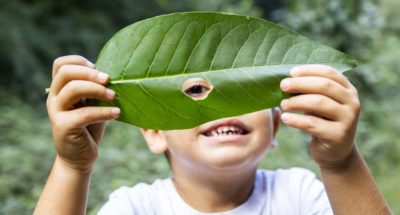
Be Like Nature: Mindfulness for Young Children
A script for educators that helps young students see their bodies as trees, their breath as wind, and their kindness and warmth as reflections of the sun

A script for educators that helps young students see their bodies as trees, their breath as wind, and their kindness and warmth as reflections of the sun
Students will:
Take a moment to step outside and appreciate the trees, the wind, and the sun. Breathe in deeply and notice how being aware of nature makes your body and your mind feel. Finish by sending loving thoughts to others.
Have students sit upright without touching their neighbors. Say:
When we go outside, we can see and feel so many wonderful things. Things like trees, and the wind, and the clouds, and the sun.
In many ways we are like these beautiful parts of nature, and for this exercise we’ll be like the tree and the wind and the sun.
Our body is like a tree. It grows and it is strong.
Our breath is like the wind. It flows in and out.
And the sun is like the part of us that is warm and kind.
So let’s lower or close our eyes and sit tall like a tree. We extend our hands way out and stretch our fingers, like branches and leaves. Let’s squeeze our fingers together and then let go and feel them wiggle, like they are blowing in the wind.
And now, with the wind blowing, let’s be like the wind and take two big, slow breaths. Breathing in…and breathing out, blowing out the wind. Breathing in…and breathing out, blowing out the wind.
And now the sun comes out and warms the tree and the wind. As it shines on the tree, we feel our body. Can you feel your fingers and feel your toes? What else can you feel—just by noticing?
And as the sun shines on the wind, we feel our body breathing. Can you feel your belly moving up and down? Can you feel the air flowing in and out of your beautiful body?
And with the sun up high in the sky, brightening and warming the whole world, you too can warm the world—with your kindness!
Think of someone who can use a little kindness—like your sister or brother, or a friend, or your teacher. And as you think of them, wish for them, “May you be happy,” imagining them smiling like the sun.
You deserve happiness, too. So now wish for yourself, “May I be happy,” and smile like the sun.
And as you smile like the sun, feel your body sitting tall like a tree and feel your breath blowing like the wind.
And then gently open your eyes and look around. You are amazing!
© 2017 Scott Rogers. All rights reserved. This adapted exercise is based on the SoBe Mindful method, a set of practices developed by Scott Rogers.
How did students respond to this practice? Where might you try it again? When might it be most well-received?
While research on the effects of mindfulness on children is still in the early stages, a 2016 review of 12 studies suggests some promising outcomes for young children relative to attention, self-regulation, and motor skills. A 2014 meta-analysis that focuses on 24 studies of K-12 students demonstrated changes in students’ attention and resilience to stress, including positive emotions, self-esteem and self-concept, and well-being.
In addition, studies with diverse student groups have found that children receive psychological and physical benefits from being exposed to nature, including better attention, self-discipline, cognitive development, decreased levels of stress, better sleep, and lower blood pressure.
“Mindfulness,” present moment awareness that is both curious and kind, can be difficult to teach as a concept. However, this practice prompts children to gently focus their attention on their bodies, their breath, and their smiles as they relate to elements in nature (e.g., trees, the wind, and the sun). In this case, young children learn about mindfulness through a concrete and kinesthetic experience grounded in their experience of the natural world.

Do you want to dive deeper into the science behind our GGIE practices? Enroll in one of our online courses for educators!
Comments